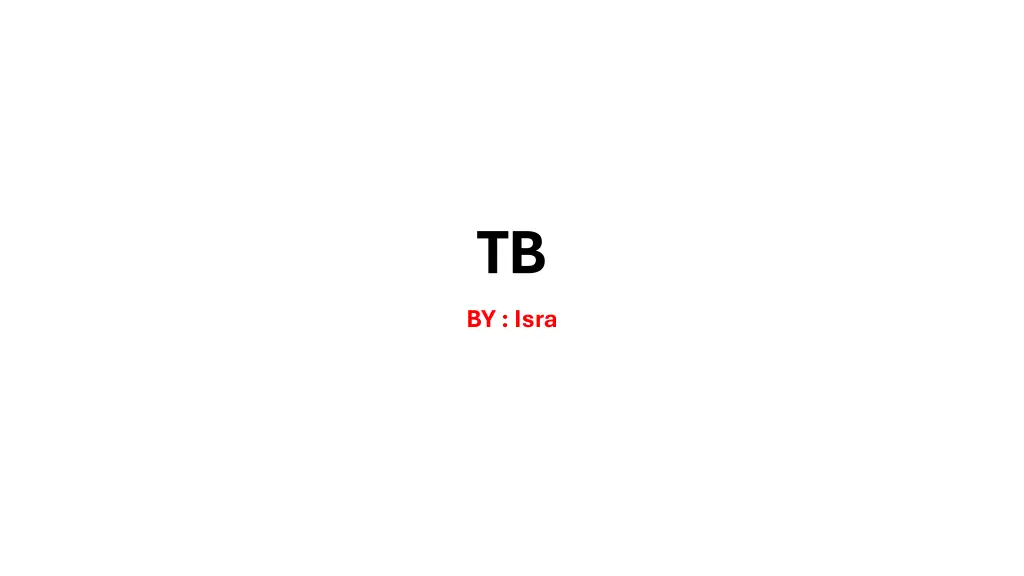
Understanding Tuberculosis: Causes, Pathophysiology, and Clinical Manifestations
Explore the world of tuberculosis (TB) - from its historical significance to its pathophysiology and clinical manifestations. Learn how TB spreads, its impact on the body, and common symptoms associated with the disease. Discover the fate of primary TB and how it can progress to secondary TB. Gain insights into the diverse clinical manifestations of TB affecting different parts of the body. Understand the importance of early detection and treatment in combating this infectious disease.
Download Presentation

Please find below an Image/Link to download the presentation.
The content on the website is provided AS IS for your information and personal use only. It may not be sold, licensed, or shared on other websites without obtaining consent from the author. If you encounter any issues during the download, it is possible that the publisher has removed the file from their server.
You are allowed to download the files provided on this website for personal or commercial use, subject to the condition that they are used lawfully. All files are the property of their respective owners.
The content on the website is provided AS IS for your information and personal use only. It may not be sold, licensed, or shared on other websites without obtaining consent from the author.
E N D
Presentation Transcript
TB BY : Isra
Tuberculosis First named Tabes will cause wasting and loss of weight . Then called white plague due to the paleness of the patient. Lastly named TB Caused by mycobacterium TB. It is transmitted by inhalation. Took the life of millions before the emergence of antituberculous medications.
Pathophysiology Mycobacterium enters by inhalation and settles in the middle and lower lobe. Macrophages ingest the mycobacterium (bacilli shape) tries to digest and destroy it but fails to do. Mycobacterium inhibits the attachment of lysosomes which inhibits its intracellular degeneration. Mycobacterium live inside the macrophages and starts multiplying. Macrophages releases cytokines: lL1, lL6, TNF Alfa , which will attract the T helper and T cytotoxic to help the infected MQ to get rid of intracellular pathogen. T lymphocytes releases interferon gamma and fibrosis occurs around the granulomatous lesion, preventing the spread of infection. This is called Ghon focus
Pathophysiology TB infections spreads to nearby hilar lymph nodes hilar lymphadenopathy occurs. Granuloma + hilar lymphadenopathy gives Ghon s complex. ( This is primary TB).
Fate of primary TB 90% undergo remission or latent TB (calcification and fibrosis occur which is called Ranke complex . 10% (immunosuppressed) : HIV , DM , organ transplant recipient the primary TB change to the progressive disease due to failure of containing the pathogen this is called primary progressive disease. If the develop immunosuppression years later the latent TB can reactivate, and this is called secondary TB.
Secondary and primary progressive Bacteria goes to the upper lobe where there is more ventilation ,since the mycobacterium thrive on oxygen. The mycobacterium divide in the upper lobe leading to damaged lung and formation of fibro-cavitation.
Clinical manifestations General features include fever, night sweat, loss of appetite Weight loss Pulmonary manifestations include cough, hemoptysis, bronchopneumonia, and pleural effusion. Systemic manifestations include the following: CNS: space occupying lesion and TB meningitis Neck: enlarged cervical lymphadenopathy scrofula . Liver: hepatitis Adrenal: primary adrenal insufficiency Peritoneum : TB peritonitis Bone-vertebra : Potts disease of spine Long bones : osteomyelitis Kidney: pyelonephritis -sterile pyuria (pus in urine).
Clinical manifestations Cardio: constrictive pericarditis (egg -shell appearance in the chest X-ray ) Spreads to the rest of the lung by blood stream and lymphatics is called miliary TB.
Investigation: PPD test ( Mantoux, tuberculin sensitivity test ) can t tell if latent or not: inject purified protein in the forearm intradermally then the results are seen after48-72 hours. A. 5 mm (considered positive if the patient is immunosuppressed or in sarcoidosis) B. 10 mm (only diagnostic if : 1-close contact 2-refuge 3-prisoner 4- healthcare worker ) C.15 mm positive in everyone False positive: BCG vaccine. False negative : HIV , sarcoidosis. IFN gamma essay to eliminate the false ( -) and (+) Chest X-Ray to differentiate between primary and secondary disease Histopathology and sputum culture gold standard investigation .
Treatment Latent : Isoniazid + B6 for 9 months or Rifampicin for 4 months . Active TB: Rifampicin , isoniazid /B6 , pyrazinamide, ethambutol or streptomycin for 2 months . Then Rifampicin + isoniazid /B6 for 4 months. Must do DOT(Direct Observe Therapy) Corticosteroids is given to TB patients in the following situations and only after starting anti-TB medications : 1-Adrenal TB as replacement therapy 2-TB meningitis to prevent adhesion and neurological deficit 3-severe miliary TB 4. TB pericarditis to prevent constrictive pericarditis
Adverse effects of Medication Rifampicin: 1-Dark red urine and tears 2-hepatic enzyme inducer Isoniazid: 1-peripheral neuropathy. 2-hepatoxicity Pyrazinamide: 1-Gouty attach 2-hepatoxicity Ethambutol : optic neuritis (Ishihara chart to check ) Streptomycin: ototoxicity, nephrotoxicity.
